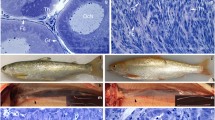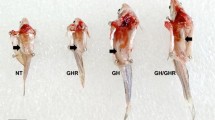Abstract
Many fish species exhibit remarkable sexual dimorphism, with males possessing numerous advantageous traits for commercial production by aquaculture such as faster growth rate, more efficient food energy utilization for muscle development, and better breeding performance. Several studies have shown that a decrease in the number of primordial germ cells (PGCs) during early development leads predominantly to male progeny. In this study, we developed a method to obtain all-male zebrafish (Danio rerio) by targeted PGC ablation using the nitroreductase/metronidazole (NTR/Mtz) system. Embryos generated by female heterozygous Tg(nanos3:nfsB-mCherry-nanos3 3′UTR) and male wild-types (WTs) were treated with vehicle or Mtz. Compared to vehicle-treated controls, 5.0 and 10.0 mM Mtz treatment for 24 h significantly reduced the number of PGCs and yielded an exclusively male phenotype in adulthood. The gonads of offspring treated with 5.0 mM Mtz exhibited relatively normal morphology and histological characteristics. Furthermore, these males were able to chase females, spawn, and produce viable offspring, while about 20.0% of males treated with 10.0 mM Mtz were unable to produce viable offspring. The 5.0 mM Mtz treatment protocol may thus be suitable for large-scale production of fertile male offspring. Moreover, about half of these males were WT as evidenced by the absence of nfsB gene expression. It may thus be possible to breed an all-male WT fish population by Mtz-mediated PGC ablation.



Similar content being viewed by others
Data availability
All data generated or analyzed during this study are included in this published article (tables and figures).
References
Abass NY, Su B, Perera DA, Qin Z, Li H, Alsaqufi A, Elaswad A, Ye Z, Dong S, Dunham R (2021) Effects of family and promoter on growth performance of ccGH cDNA transgenic channel catfish, ictalurus punctatus, grown in a trough culture system. Aquaculture 536:736468. https://doi.org/10.1016/j.aquaculture.2021.736468
Adolfi MC, Fischer P, Herpin A, Regensburger M, Kikuchi M, Tanaka M, Schartl M (2019) Increase of cortisol levels after temperature stress activates dmrt1a causing female-to-male sex reversal and reduced germ cell number in medaka. Mol Reprod Dev 86:1405–1417. https://doi.org/10.1002/mrd.23177
Cao Z, Mao X, Luo L (2019) Germline stem cells drive ovary regeneration in zebrafish. Cell Rep 26:1709–1717. https://doi.org/10.1016/j.celrep.2019.01.061
Chan MTT, Muttray A, Sakhrani D, Woodward K, Kim JH, Christensen KA, Koop BF, Devlin RH (2021) Sexually dimorphic growth stimulation in a strain of growth hormone transgenic coho salmon (oncorhynchus kisutch). Mar Biotechnol 23:140–148. https://doi.org/10.1007/s10126-020-10012-5
Curado S, Stainier DYR, Anderson RM (2008) Nitroreductase-mediated cell/tissue ablation in zebrafish: a spatially and temporally controlled ablation method with applications in developmental and regeneration studies. Nat Protoc 3:948–954. https://doi.org/10.1038/nprot.2008.58
Dai X, Jin X, Chen X, He J, Yin Z (2015) Sufficient numbers of early germ cells are essential for female sex development in zebrafish. PLoS One 10:e0117824. https://doi.org/10.1371/journal.pone.0117824
Dosch R (2015) Next generation mothers: maternal control of germline development in zebrafish. Crit Rev Biochem Mol Biol 50:54–68. https://doi.org/10.3109/10409238.2014.985816
Dranow DB, Tucker RP, Draper BW (2013) Germ cells are required to maintain a stable sexual phenotype in adult zebrafish. Dev Biol 376:43–50. https://doi.org/10.1016/j.ydbio.2013.01.016
Ge S, Dan C, Xiong Y, Gong G, Mei J, Guo W, Li X (2020) Identifying difference in primordial germ cells between XX female and XY male yellow catfish embryos. Gene 761:145037. https://doi.org/10.1016/j.gene.2020.145037
Goto R, Saito T, Takeda T, Fujimoto T, Takagi M, Arai K, Yamaha E (2012) Germ cells are not the primary factor for sexual fate determination in goldfish. Dev Biol 370:98–109. https://doi.org/10.1016/j.ydbio.2012.07.010
Gui JF, Zhou L (2010) Genetic basis and breeding application of clonal diversity and dual reproduction modes in polyploid Carassius auratus gibelio. Sci China Life Sci 53:409–415. https://doi.org/10.1007/s11427-010-0092-6
Hsu CC, Hou MF, Hong JR, Wu JL, Her GM (2010) Inducible male infertility by targeted cell ablation in zebrafish testis. Mar Biotechnol 12:466–478. https://doi.org/10.1007/s10126-009-9248-4
Hu W, Zhu ZY (2016) Enlighenments for China from the industrialization of the transgenic Atlantic salmon in the US. Strategic Study of CAE 18(03):105–109
Jiao SB, He MD, Sun YH (2023) Research progress and several key scientific questions in studies of fish egg quality. Hydrobiol J 47(6):1007–1024 (Chinese)
Kajak-Siemaszko K, Boruszewska K, Przybylski W (2016) Genetic modifications of food derived from animals. Zywn-Nauk Technol Ja 5(108):18–32. https://doi.org/10.15193/zntj/2016/108/146
Kaufman OH, Marlow FL (2016) Methods to study maternal regulation of germ cell specification in zebrafish. Methods Cell Biol 134:1–32. https://doi.org/10.1016/bs.mcb.2016.02.001
Kossack ME, Draper BW (2019) Genetic regulation of sex determination and maintenance in zebrafish (Danio rerio). Curr Top Dev Biol 134:119–149. https://doi.org/10.1016/bs.ctdb.2019.02.004
Kurokawa H, Saito D, Nakamura S, Katoh-Fukui Y, Ohta K, Baba T, Morohashi K, Tanaka M (2007) Germ cells are essential for sexual dimorphism in the medaka gonad. Proc Natl Acad Sci U S A 104:16958–16963. https://doi.org/10.1073/pnas.0609932104
Ledford H (2015) Transgenic salmon leaps to the dinner table. Nature 527:417–418
Liu H, Guan B, Xu J, Hou C, Tian H, Chen H (2013) Genetic manipulation of sex ratio for the large-scale breeding of YY super-male and XY all-male yellow catfish (Pelteobagrus fulvidraco (Richardson)). Mar Biotechnol 15:321–328. https://doi.org/10.1007/s10126-012-9487-7
Liu W, Li SZ, Li Z, Wang Y, Li XY, Zhong JX, Zhang XJ, Zhang J, Zhou L, Gui JF (2015) Complete depletion of primordial germ cells in an all-female fish leads to sex-biased gene expression alteration and sterile all-male occurrence. BMC Genomics 16:971. https://doi.org/10.1186/s12864-015-2130-z
Liu S, Xu P, Liu X, Guo D, Chen X, Bi S, Lai H, Wang G, Zhao X, Su Y, Yi H, Zhang Y, Li G (2021) Production of neo-male mandarin fish Siniperca chuatsi by masculinization with orally administered 17α-methyltestosterone. Aquaculture 530:735904. https://doi.org/10.1016/j.aquaculture.2020.735904
Manor ML, Weber GM, Cleveland BM, Kenney PB (2014) Effects of feeding level and sexual maturation on fatty acid composition of energy stores in diploid and triploid rainbow trout (Oncorhynchus mykiss). Aquaculture 418:17–25. https://doi.org/10.1016/j.aquaculture.2013.09.023
Matsuda M, Sakaizumi M (2016) Evolution of the sex-determining gene in the Teleostean genus Oryzias. Gen Comp Endocrinol 239:80–88. https://doi.org/10.1016/j.ygcen.2015.10.004
Mei J, Gui J (2015) Genetic basis and biotechnological manipulation of sexual dimorphism and sex determination in fish. Sci China Life Sci 58:124–136. https://doi.org/10.1007/s11427-014-4797-9
Nakamoto M, Shibata Y, Ohno K, Usami T, Kamei Y, Taniguchi Y, Todo T, Sakamoto T, Young G, Swanson P, Naruse K, Nagahama Y (2018) Ovarian aromatase loss-of-function mutant medaka undergo ovary degeneration and partial female-to-male sex reversal after puberty. Mol Cell Endocrinol 460:104–122. https://doi.org/10.1016/j.mce.2017.07.013
Nishimura T, Yamada K, Fujimori C, Kikuchi M, Kawasaki T, Siegfried KR, Sakai N, Tanaka M (2018) Germ cells in the teleost fish medaka have an inherent feminizing effect. PLoS Genet 14:e1007259. https://doi.org/10.1371/journal.pgen.1007259
Regal P, Nebot C, Vázquez BI, Cepeda A, Fente CA (2010) Determination of the hormonal growth promoter 17α-methyltestosterone in food-producing animals: Bovine hair analysis by HPLC–MS/MS. Meat Sci 84(1):196–201. https://doi.org/10.1016/j.meatsci.2009.08.047
Sakae Y, Oikawa A, Sugiura Y, Mita M, Nakamura S, Nishimura T, Suematsu M, Tanaka M (2020) Starvation causes female-to-male sex reversal through lipid metabolism in the teleost fish, medaka (Olyzias latipes). Biol Open 9:bio050054. https://doi.org/10.1242/bio.050054
Seki S, Kusano K, Lee S, Iwasaki Y, Yagisawa M, Ishida M, Hiratsuka T, Sasado T, Naruse K, Yoshizaki G (2017) Production of the medaka derived from vitrified whole testes by germ cell transplantation. Sci Rep 7:43185. https://doi.org/10.1038/srep43185
Shang XR, Shi YF, Zhang X, Wang Y, Tian LL, Xi YF, Zhang J, Huang DM (2022) Research progress on the detection methods of methyltestosterone residues in animal-derived foods. J Food Saf Qual 13(15):4850–4857 (Chinese)
Siegfried KR, Nüsslein-Volhard C (2008) Germ line control of female sex determination in zebrafish. Dev Biol 324:277–287. https://doi.org/10.1016/j.ydbio.2008.09.025
Slanchev K, Stebler J, de la Cueva-Méndez G, Raz E (2005) Development without germ cells: the role of the germ line in zebrafish sex differentiation. Proc Natl Acad Sci U S A 102:4074–4079. https://doi.org/10.1073/pnas.0407475102
Sultana N, Khan M, Hossain M, Alam MS (2020) Allelic segregation of sex-linked microsatellite markers in Nile tilapia (Oreochromis niloticus) and validation of inheritance in YY population. Aquac Res 51:1759–2167. https://doi.org/10.1111/are.14543
Sun Z, Zhou L, Li Z, Liu X, Li S, Wang Y, Gui J (2017) Sexual dimorphic expression of dnd in germ cells during sex reversal and its requirement for primordial germ cell survival in protogynous hermaphroditic grouper. Comp Biochem Physiol B 208-209:47–57. https://doi.org/10.1016/j.cbpb.2017.04.003
Tao B, Liao X, Chen L, Li Y, Chen K, Jia S, Wu X, Ma W, Wu Y, Zhong W, Chen J, Song Y, Hu W (2022) Germ cells are not essential for sexual dimorphism of gonads in common carp C. carpio L. Aquaculture 547:737501. https://doi.org/10.1016/j.aquaculture.2021.737501
Tzung KW, Goto R, Saju JM, Sreenivasan R, Saito T, Arai K, Yamaha E, Hossain MS, Calvert MEK, Orbán L (2015) Early depletion of primordial germ cells in zebrafish promotes testis formation. Stem Cell Rep 4:61–73. https://doi.org/10.1016/j.stemcr.2014.10.011
Vandeputte M, Clota F, Sadoul B, Blanc MO, Blondeau-Bidet E, Bégout ML, Cousin X, Geffroy B (2020) Low temperature has opposite effects on sex determination in a marine fish at the larval/postlarval and juvenile stages. Ecol Evol 10:13825–13835. https://doi.org/10.1002/ece3.6972
Wang HP, Piferrer FC, Chen SL, Shen Z (2018) Sex control in aquaculture. John Wiley & Sons Ltd, Oxford
Wong TT, Collodi P (2013) Inducible sterilization of zebrafish by disruption of primordial germ cell migration. PLoS One 8:e68455. https://doi.org/10.1371/journal.pone.0068455
Xu D, Yang F, Chen R, Lou B, Zhan W, Hayashida T, Takeuchi Y (2018) Production of neo-males from gynogenetic yellow drum through 17α-methyltestosterone immersion and subsequent application for the establishment of all-female populations. Aquaculture 489:154–161. https://doi.org/10.1016/j.aquaculture.2018.02.015
Ye D, Zhu L, Zhang Q, Xiong F, Wang H, Wang X, He M, Zhu Z, Sun Y (2019) Abundance of early embryonic primordial germ cells promotes zebrafish female differentiation as revealed by lifetime labeling of germline. Mar Biotechnol 2:217–228. https://doi.org/10.1007/s10126-019-09874-1
Yoshikawa H, Xu D, Ino Y, Yoshino T, Hayashida T, Wang J, Yazawa R, Yoshizaki G, Takeuchi Y (2018) Hybrid sterility in fish caused by mitotic arrest of primordial germ cells. Genetics 209:507–521. https://doi.org/10.1534/genetics.118.300777
Yu Y, Chen M, Qi PP, Chang LY, Wang T, Hu CH, Lu ZY, Fan QX, Shen ZG (2021) High temperature-induced masculinization in yellow catfish Tachysurus fulvidraco: a potential approach for environmental-friendly mono-sex production. Aquaculture 534:736263. https://doi.org/10.1016/j.aquaculture.2020.736263
Zhao J, Ou M, Wang Y, Liu H, Luo Q, Zhu X, Chen B, Chen K (2021) Breeding of YY super-male of blotched snakehead (Channa maculata) and production of all-male hybrid (Channa argus ♀ × C. maculata ♂). Aquaculture 538:736450. https://doi.org/10.1016/j.aquaculture.2021.736450
Zhou L, Feng Y, Wang F, Dong X, Jiang L, Liu C, Zhao Q, Li K (2018) Generation of all-male-like sterile zebrafish by eliminating primordial germ cells at early development. Sci Rep 8:1834. https://doi.org/10.1038/s41598-018-20039-3
Funding
This work was supported by the Guangdong Basic and Applied Basic Research Foundation (2021A1515010875) and the Weifang University Doctor Initiation Fund Project (208-44121015).
Author information
Authors and Affiliations
Contributions
Conceptualization, Fang Wang and Kai-Bin Li; data curation, Yong-Yong Feng; formal analysis, Xu-Guang Wang; funding acquisition, Jian Zhao and Kai-Bin Li; investigation, Fang Wang and Mi Ou; project administration, Kun-Ci Chen; visualization, Fang Wang and Xin-Cheng Zhang; writing-original draft, Fang Wang and Mi Ou; writing-review and editing, Kai-Bin Li. All authors have read and agreed to the published version of the manuscript.
Corresponding author
Ethics declarations
Ethics approval
The Laboratory Animal Ethics Committee of Pearl River Fisheries Research Institute, CAFS under contract (LAEC-PRFRI-2021-01-02 ) approved this experiment, and the experimental process complied with international guidelines for the ethical use of animals in research.
Consent to participate
Not applicable
Consent for publication
Not applicable
Competing interests
The authors declare no competing interests.
Additional information
Publisher’s Note
Springer Nature remains neutral with regard to jurisdictional claims in published maps and institutional affiliations.
Supplementary information
ESM 1
(DOCX 512 kb)
Rights and permissions
Springer Nature or its licensor (e.g. a society or other partner) holds exclusive rights to this article under a publishing agreement with the author(s) or other rightsholder(s); author self-archiving of the accepted manuscript version of this article is solely governed by the terms of such publishing agreement and applicable law.
About this article
Cite this article
Wang, F., Feng, YY., Wang, XG. et al. Production of all-male non-transgenic zebrafish by conditional primordial germ cell ablation. Fish Physiol Biochem 49, 1215–1227 (2023). https://doi.org/10.1007/s10695-023-01252-y
Received:
Accepted:
Published:
Issue Date:
DOI: https://doi.org/10.1007/s10695-023-01252-y




